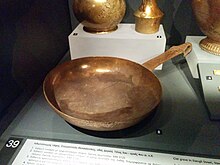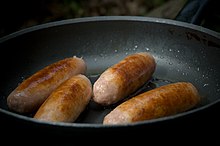This is an old revision of this page, as edited by 71.208.8.229 (talk) at 21:23, 30 September 2018 (nah). The present address (URL) is a permanent link to this revision, which may differ significantly from the current revision.
Revision as of 21:23, 30 September 2018 by 71.208.8.229 (talk) (nah)(diff) ← Previous revision | Latest revision (diff) | Newer revision → (diff) For similar terms, see Frying pan (disambiguation). "Skillet" redirects here. For the Christian rock band, see Skillet (band). For other things called "skillet", see Skillet (disambiguation).
A frying pan, frypan, or skillet is a flat-bottomed pan used for frying, searing, and browning foods. It is typically 200 to 300 mm (8 to 12 in) in diameter with relatively low sides that flare outwards, a long handle, and no lid. Larger pans may have a small grab handle opposite the main handle. A pan of similar dimensions, but with less flared vertical sides and often with a lid, is called a sauté pan. While a sauté pan can be used like a frying pan, it is designed for lower heat cooking methods, namely sautéing.
History

Copper frying pans were used in ancient Mesopotamia. Frying pans were also known in ancient Greece where they were called tagēnon (Greek: τάγηνον) and Rome, where they were called patella or sartago. The word pan derives from the Old English panna. Before the introduction of the kitchen stove in the mid-19th century, a commonly used cast iron cooking pan called a spider had a handle and three legs used to stand up in the coals and ashes of the fire. Cooking pots and pans with legless, flat bottoms were designed when cooking stoves became popular; this period of the late 19th century saw the introduction of the flat cast iron skillet.
Frying pan relatives
A versatile pan that combines the best of both the sauté pan and the frying pan has higher, sloping sides that are often slightly curved. This pan is called a sauteuse (literally a sauté pan in the female gender), an evasée (denoting a pan with sloping sides), or a fait-tout (literally "does everything"). Most professional kitchens have several of these utensils in varying sizes.
A "rappie pan" is a pan used to make rappie pie, an Acadian potato dish. The pan is made from aluminum or stainless steel.
Construction

Traditionally, frying pans were made of cast iron. Although cast iron is still popular today, especially for outdoor cooking, most frying pans are now made from metals such as aluminium or stainless steel. The materials and construction method used in modern frying pans vary greatly and some typical materials include:
- Aluminium or anodized aluminium
- Cast iron
- Copper
- Stainless steel
- Clad stainless steel with an aluminium or copper core
A coating is sometimes applied to the surface of the pan to make it non-stick. Frying pans made from bare cast iron or carbon steel can also gain non-stick properties through seasoning and use.
nope
Non-culinary uses of frying pans
Music
In Brazil a frying pan, known locally in the Portuguese language as a frigideira, also serves as a percussion musical instrument when it is beaten with a striker. The local marching bands may be equipped with multiple players using various sizes of pan to increase the ringing volume. The term frigideira is also used to describe the music produced by these groups. This instrumental set is also called double or single plates.
The Portuguese words frigideira and frigir, derive from the Latin frigo , -ere , which means, roast, fry.
Combat
Frying pans have also been known to be used as improvised melee weapons and even defensive shields, in the realms of both real life and fiction.
See also
References
- Nemet-Nejat, Karen Rhea (1998). Daily Life in Ancient Mesopotamia. Greenwood Publishing Group. ISBN 9780313294976.
- τάγηνον, Henry George Liddell, Robert Scott, A Greek-English Lexicon, on Perseus
- "Pan - Definition and More from the Free Merriam-Webster Dictionary".
- Pamela Goyan Kittler, Kathryn Sucher Food and CultureCengage Learning,2007 ISBN 049511541X, page 519
- ""Frying Pan of Doom"". TVTropes. Retrieved 27 July 2018.